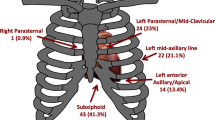Abstract
Purpose
Percutaneous catheter drainage (PCD) has been considered a standard method of relieving acute cardiac tamponade. Although conventional subxiphoid pericardiotomy is useful even for clotted hemopericardium, it has been believed to be unsuitable for emergency treatment because it is a time-consuming procedure. We report our modified pericardiotomy technique that can be used for emergency management.
Methods
We designed a prospective observational study to evaluate blind subxiphoid pericardiotomy (BSP) for critical cardiac tamponade due to hemopericardium. Emergency patients (n = 148) with acute hemopericardium secondary to trauma (n = 12), acute aortic disease (n = 122), or cardiac rupture following acute myocardial infarction (n = 14) were the subjects. Early results were compared between the BSP group (n = 53) and the PCD group (n = 95).
Results
BSP was effective at relieving cardiac tamponade in all 53 cases, but PCD was ineffective in 12 cases (12.6 %, p = 0.008). Procedure-related complication rates of BSP and PCD were 0 and 16.8 %, respectively (p = 0.002). Survival rates for the BSP and PCD groups were 18.9 and 6.3 %, respectively (p = 0.018). Since 2005, when we discarded the restriction that only board-certified surgeons should perform BSP, acute care physicians (including trainees) have performed BSP for 22 patients without procedure-related complications.
Conclusions
BSP was safe and effective for cardiac tamponade due to acute hemopericardium. Critical complications during PCD for hemopericardium could not be avoided in some cases because of clots in the pericardium.

Similar content being viewed by others
References
Maggiolini S, Bozzano A, Russo P, Vitale G, Osculati G, Cantù E, Achilli F, Valagussa F. Echocardiography-guided pericardiocentesis with probe-mounted needle: report of 53 cases. J Am Soc Echocardiogr. 2001;14:821–4.
Tsang TS, Enriquez-Sarano M, Freeman WK, Barnes ME, Sinak LJ, Gersh BJ, Bailey KR, Seward JB. Consecutive 1127 therapeutic echocardiographically guided pericardiocenteses: clinical profile, practice patterns, and outcomes spanning 21 years. Mayo Clin Proc. 2002;77:429–36.
Marcy PY, Bondiau PY, Brunner P. Percutaneous treatment in patients presenting with malignant cardiac tamponade. Eur Radiol. 2005;15:2000–9.
Wong B, Murphy J, Chang CJ, Hassenein K, Dunn M. The risk of pericardiocentesis. Am J Cardiol. 1979;44:1110–4.
Duncan AO, Scalea TM, Sclafani SJ, Phillips TF, Bryan D, Atweh NA, Vieux EE. Evaluation of occult cardiac injuries using subxiphoid pericardial window. J Trauma. 1989;29:955–9.
Kurimoto Y, Hase M, Nara S, Yama N, Kawaharada N, Higami T, Asai Y. Blind subxiphoid pericardiotomy for cardiac tamponade because of acute hemopericardium. J Trauma. 2006;61:582–5.
Asai Y, Yoshida M, Kurimoto Y, Arnold JL. Case report: penetrating cardiac injury secondary to a terrorism-related nail bomb explosion. Prehosp Disast Med. 2003;18:249–52.
Palantianos GM, Thurer RJ, Pompeo MQ, Kaiser GA. Clinical experience with subxiphoid drainage of pericardial effusions. Ann Thorac Surg. 1989;48:381–5.
Dosios T, Theakos N, Angouras D, Asimacopoulos P. Risk factors affecting the survival of patients with pericardial effusion submitted to subxiphoid pericardiostomy. Chest. 2003;124:242–6.
Becit N, Unlu Y, Ceviz M, Kocogullari CU, Kocak H, Guriertop Y. Subxiphoid pericardiostomy in the management of pericardial effusions: case series analysis of 368 patients. Heart. 2005;91:785–90.
Allen KB, Faber LP, Warren WH, Shaar CJ. Pericardial effusion: subxiphoid pericardiostomy versus percutaneous catheter drainage. Ann Thorac Surg. 1999;67:437–40.
McDonald JM, Meyers BF, Guthrie TJ, Battafarano RJ, Cooper JD, Patterson GA. Comparison of open subxiphoid pericardial drainage with percutaneous catheter drainage for symptomatic pericardial effusion. Ann Thorac Surg. 2003;76:811–5.
Harris DG, Papagiannopoulos KA, Pretorius J, Van Rooyen T, Rossouw GJ. Current evaluation of cardiac stab wounds. Ann Thorac Surg. 1999;68:2119–22.
Navsaria PH, Nicol AJ. Haemopericardium in stable patients after penetrating injury: is subxiphoid pericardial window and drainage enough? A prospective study. Injury. 2005;36:745–50.
Navsaria PH. Blind subxiphoid pericardiotomy and emergency physicians performing percutaneous catheter drainage. J Trauma. 2007;62:264.
Kurimoto Y, Kano H, Yama N, Nara S, Hase M, Asai Y. Out-of-hospital cardiopulmonary arrest due to penetrating cardiac injury treated by percutaneous cardiopulmonary support in the emergency room: report of a case. Surg Today. 2007;37:240–2.
Wang RF, Chao CC, Wang TL, Chen KC, Chong CF, Huang KH, Chen CC. The effect of different relieving methods on the outcome of out-of-hospital cardiac arrest patients with nontraumatic hemopericardium in the ED. Am J Emer Med. 2008;26:425–32.
Conflict of interest
None.
Author information
Authors and Affiliations
Corresponding author
Electronic supplementary material
Below is the link to the electronic supplementary material.
A video of a blind subxiphoid pericardiotomy procedure. The patient was admitted by ambulance in deep shock due to cardiac tamponade. Because of a lack of information about the causative disease at his arrival, emergency blind subxiphoid pericardiotomy was employed to allow time for evaluation. Following pericardiotomy under local anesthesia, CT revealed acute type A aortic dissection. This procedure can usually be performed in a minute. (MPG 9425 kb)
Rights and permissions
About this article
Cite this article
Kurimoto, Y., Maekawa, K., Tanno, K. et al. Blind subxiphoid pericardiotomy to relieve critical acute hemopericardium: a final report. Eur J Trauma Emerg Surg 38, 563–568 (2012). https://doi.org/10.1007/s00068-012-0200-3
Received:
Accepted:
Published:
Issue Date:
DOI: https://doi.org/10.1007/s00068-012-0200-3




